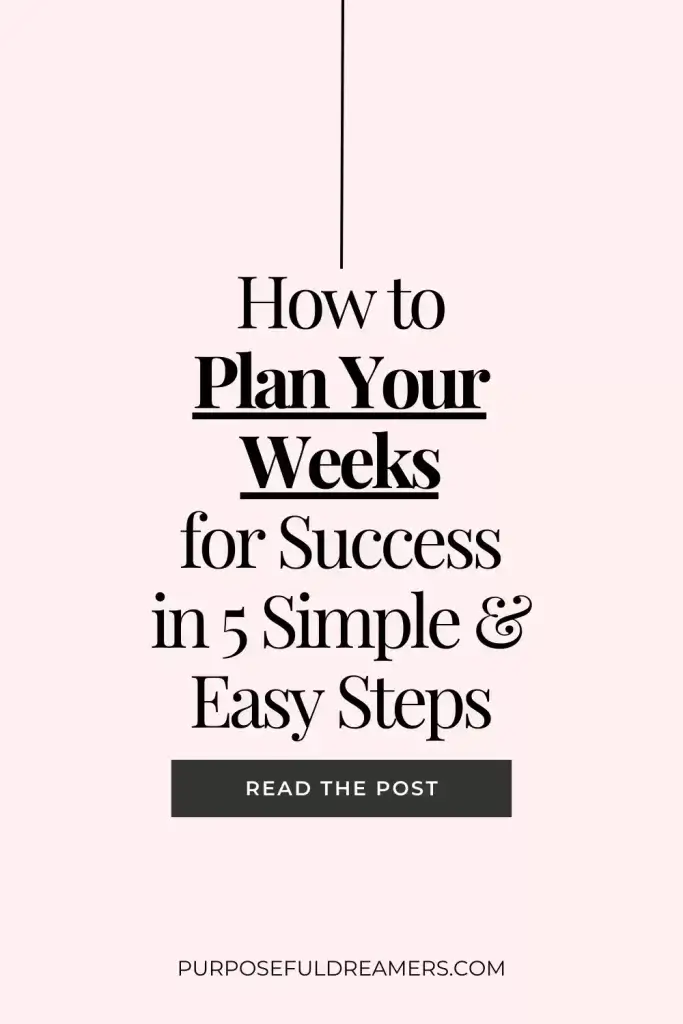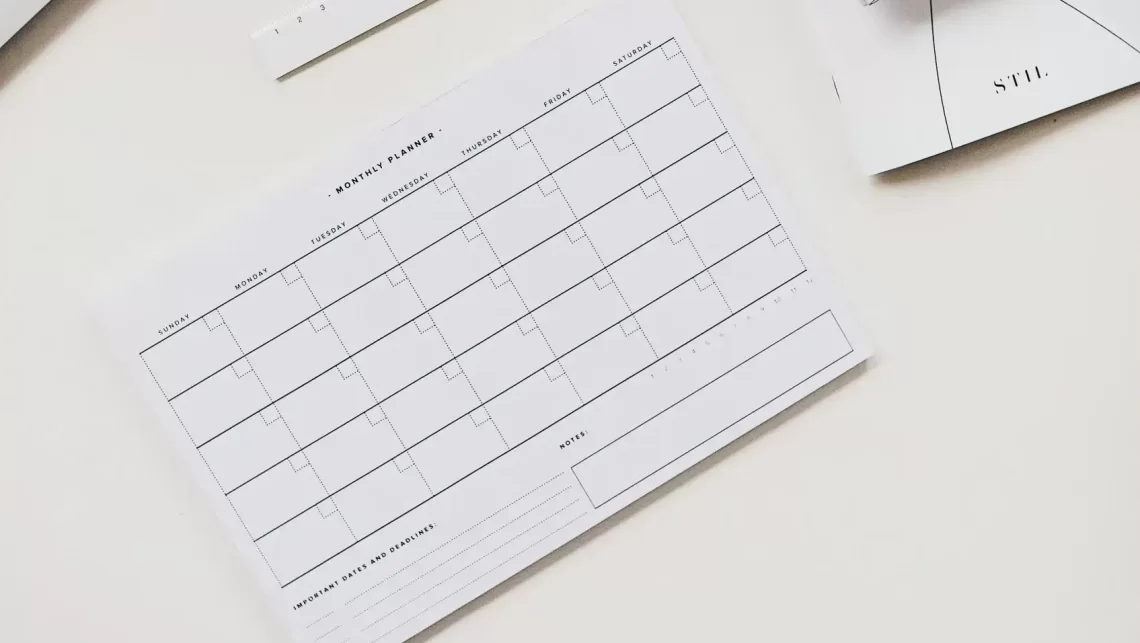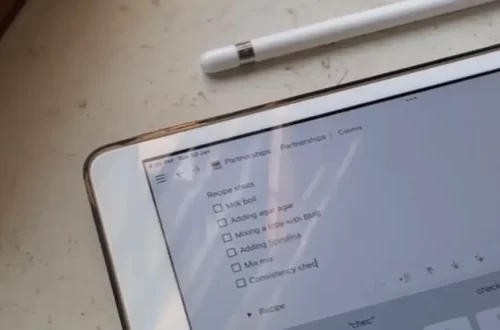One way to shake off your ‘Sunday scaries‘ and start the week with a fresh mindset is to create a weekly planning routine.
Maybe now it doesn’t sound that exciting but trust me, if you give it a go, you won’t be able to live without it! 😉
Forget the chaos, the last-minute planning, or the stress of dealing with too many things simultaneously.
Planning your week will help you laser-focus on what matters so that you can eliminate the unnecessary stuff.
Are you ready to live more organized (and relaxing) weeks? Then, let’s get started!
DISCLAIMER: This blog is reader-supported. When you buy through links on this site, I may earn an affiliate commission (which won’t affect your final price). I only promote products that I consider valuable and beneficial for you. If you decide to purchase something – Thank you for buying me a cup of coffee! xx
📌 SHORT ON TIME? PIN IT FOR LATER! 📌

Why you need to plan your week
Planning for the upcoming week has many benefits. For example, it helps you:
- Be more productive right away
- Feel less stressed and overwhelmed
- Be more focused on the task at hand
- Manage your time more efficiently
- Stay on track with your long-term goals
There’s no better feeling than starting your Mondays already knowing what your day – and week – will look like. You don’t have to jump from one place to the other, or make up a plan on the go because it’s already done for you! 😉
Sure, you might not feel thrilled on Sunday afternoon, when it’s time to pull out your planner and think about next week. But, sooner or later, you’ll realize that those 20 minutes on Sunday are well-spent because they make you save hours and hours of distractions, unclarity, and procrastination.
5 Key Steps for a Simple Weekly Planning Routine
You can use your notes app, a cute planner, or even write on a blank sheet. Do what works for you – no judgment.
PSST. Or you can decide to grab my FREE WEEKLY PLANNER! 😉
Here are the 5 steps for a great weekly planning session:
1. Set weekly goals
First things first, you’ve gotta set some goals. What do you hope to achieve this week?
When setting your weekly goals, you should aim somewhere between 3 and 5. Going above that number will not help you – it’s just 7 days, so be realistic about how much you can accomplish!
Some examples of weekly goals are:
- Journal daily
- Meditate every day
- Drink 60oz of water
- Spend max. 1h online
- Workout 3 times
- Read every day
- Express daily gratitude
- Wake up early
- Go on a daily walk
- Reach out to and connect with two friends
2. Goals alignment check
This step is important – so don’t skip it!
An important question you must ask yourself after setting any goal is: “Does this goal support the life I’m trying to create for myself?”.
We all have a vision. We all have an ideal future. And we all have a dream life we can’t wait to wake up to!
So, the question is: are your actions reflecting that? Are you moving in the right direction? Are you getting closer to living your dream life?
Because if you realize your goals aren’t taking you anywhere, you should set new goals.
Here is what I mean by analyzing whether your goals align with your life vision:
- Journaling, meditating, and expressing gratitude are great goals if you want to raise your self-awareness and become more mindful
- Drinking more water, working out, and going on daily walks are perfect goals if you’re trying to become healthier
- Limiting your screen time and waking up early are good goals if you’re hoping to get more productive
See? All goals should link back to an overall biggest purpose, otherwise they’re just meaningless.

3. Define your action plan
Next, the third step for a good weekly planning routine is crafting your strategy. You’ve got your goals and you know why you’re chasing them – awesome!
Now, you’ve got to focus on how exactly you will make it happen.
For each weekly goal you set, I want you to define the place and time you will work on it. Be as specific as possible.
For example, let’s say your goal is journaling every day. Don’t just leave it like that! You must write: “Every day, at 9.30 PM, which is when I tuck myself into bed, I will journal for 20 minutes”. If you can specify even what you will journal about – that’s even better!
Maybe your goal is to work out 3 times per week. Write: “I will work out on Monday, Wednesday, and Friday for 1 hour at the gym. On Monday, I will train the back; on Wednesday I will do legs; and on Friday I will focus on the abs”.
Or if your goal is waking up early, specify: “I will wake up at 6 AM every morning. I will journal, read, meditate, and practice some yoga. At 7 AM I will have breakfast and get ready for the day”.
If you have many great goals but are struggling to achieve them, grab my “90-DAY GOAL ACTION PLAN” – it’s the only resource you need to crush all your goals! 😉
4. Have a backup plan
Life doesn’t always go as planned, right? You already know that.
But the unpredictability of life won’t scare you if you’re prepared even for the unforeseen 😉
That’s the main reason why I recommend you create a backup plan…just in case your plan A fails.
Having a backup plan will allow you to still make progress toward your goals, although it might be at a slower pace than you expected. Still – small progress is better than none!
Considering the example of working out 3 times per week:
- Plan A is → Going to the gym 3 times a week for 1 hour
- Plan B is → Doing 3 at-home workouts for 30 minutes
You’re still making progress toward your overall goal of becoming a healthier person – so that’s an achievement in itself!
Or, if your goal is waking up early, your:
- Plan A is → Waking up at 6 AM every morning
- Plan B is → Waking up at 6.30 AM
You’re still getting up earlier, but you’ll probably have to cut down the number of activities included in your morning routine.
5. Measure the results
Finally, the last step of your weekly planning routine should focus on measuring the results you’ve achieved.
You must have a clear outcome in mind when you set goals.
Make it measurable. Quantify your goal. Write it down in numbers.
Translate “waking up early” to “waking up at 6 AM”, so that you’ll know you’ll have achieved your goal once you jump out of bed at 6 sharp.
Instead of setting the goal of “reading more”, why don’t you get more specific? How many pages of a book do you want to read per day? Or, how many books do you want to have read by the end of the year?
Translate “meditating daily” to “meditating for 30 minutes every day” and build your way up. Start with meditating for 5 minutes, then 10, 15, and so on. When you’re able to meditate for 30 minutes straight, you’ll know you’ll have achieved your bigger, broader goal.
You can only know whether you’ve hit your goal or not if you can measure your efforts.
Since there is so much you can do in a week, take your bigger goal and break it down into monthly, weekly, and daily steps you can take.
Every successful week is a week closer to living as your ideal self.
📌 LIKED THE ARTICLE? SHARE YOUR LOVE! 📌

BONUS: Weekly Review
Other than having a good weekly planning system in place, there’s another important process you should consider doing – that’s doing a weekly review.
Right before planning for the upcoming week, take some time to reflect on the past seven days.
RELATED: Read here “The Ultimate Sunday Reset Routine for a Great Week Ahead”
Conclusion
That’s all for me today!
Let’s do a quick recap – these are the 5 steps you must take to plan your week:
- Set 3-5 weekly goals
- Do a goal-alignment check
- Create a solid action plan
- Have a backup plan
- Measure your weekly progress
Q: “Do you currently have a weekly planning routine? If so, what steps do you take to plan your week?” – Let me know in a comment! 🙂
Until next time,







